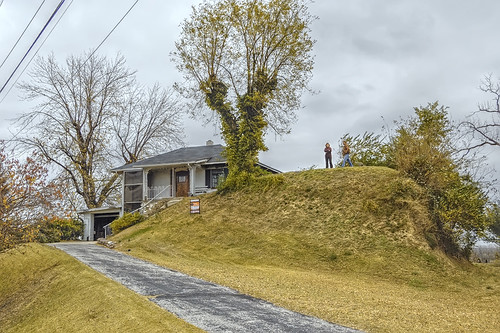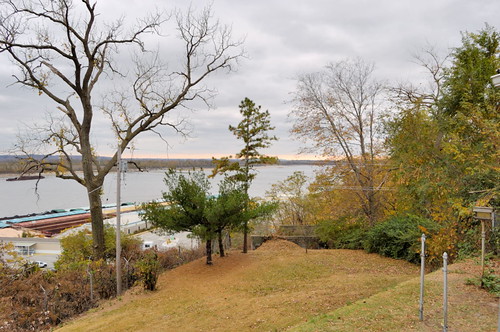As you drive north on I-55, just beyond the Broadway exit, you are treated to a glimpse of the river to the right; and a bit farther along, you see, quite prominently, a small white house located near the summit of a steep-sided earthen mound. Local commuters no doubt have seen this mound many times, and the little house, built so obviously on it.

This is Sugarloaf Mound, reputed to be the last remaining Indian mound in the City. It got its name due to its resemblance to the shape of the hard loaves of sugar that were sold in former times.
There were once many prehistoric mounds in the City, so many that it received the nickname "Mound City", the memory of which is still found in the names of a number of surviving business. But pride, progress, or coldness of heart eventually erased all of these mounds but one.
You can now purchase it, if you want. The current owners, Walter and Eileen Strosnider (who according to my parents are a very charming couple) purchased the house and mound in 1962 but lately have moved to California to be near their daughter. They purchased this admittedly modest home specifically because of its view. Walter had a love of the river ever since he was a member of the Saint Louis Rowing Club, which rowed Charles-River-in-Boston-style racing shells on the stretch of the Mississippi River below this house.

View of the Mississippi River from the house's back porch. The Mississippi is now mainly an industrial river, but it still is scenic yet busy with barge traffic. Very few homes here have a view of the river, and those that do rarely stay on the market for very long.
According to a book by Robert Ramsay, dating from 1948, traces of one other Indian mound in the City, Côte Brilliante (supposedly French for 'bright hill'), were still to be found, but I am not able to confirm this. Reportedly, it is near the intersection of Martin Luther King and Kingshighway; at that location is Sherman Park, which is also bounded by Cote Brilliante Avenue.
What appears, to me at least, to be the remains of an Indian mound are found across Adelaide Avenue from the Pink Sisters Chapel. This obviously artificial mound, sitting as it does on the edge of the bluff line overlooking the river, seems to be a perfect place for a small cemetery. No doubt there are the remains of other mounds to be found in the City, unknown and unnoticed, as there are many that can be found in outlying regions, including most famously the Cahokia Mounds.
Sugarloaf Mound may have been the foundation for a temple or the house of a chief, but most likely is a burial mound. Requiescant in pace.


O'Fallon Park is across the street from the Pink Sisters' Chapel, and was once the estate of Colonel John R. O'Fallon (1791-1865); his home was built atop an Indian burial mound.
ReplyDeletehttp://stlouis.missouri.org/ofallon/history.htm
Thank you for mentioning us in your blog. You have a mention in ours now as well.
ReplyDeleteSherman park certainly looks like a step pyramid with three levels.
ReplyDeleteIts northern border is Cote Brilliante Avenue. Connection?
Yes, that could be the remains of the Côte Brilliante mound which was at that spot.
DeleteMany additional mounds can be seen at Pere Marquette State Park, near Grafton, Illinois.
Also, since I’ve written this article, I think I’ve seen the remains of more mounds within the city limits.